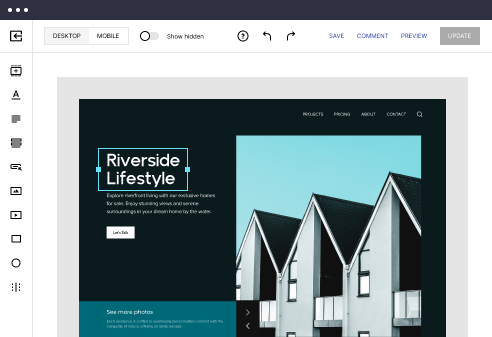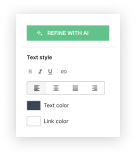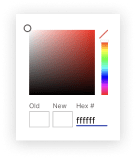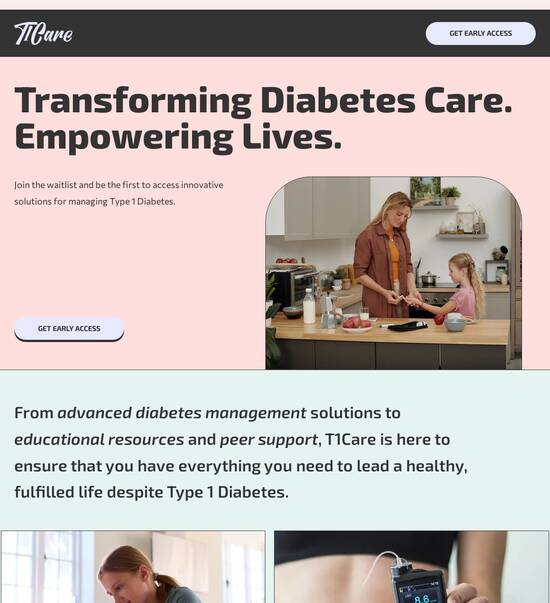
HTML page template for Python developers
Use TemplateAbout template
Attract clients and showcase your skills with style using our landing page templates for Python developers. Let's convert those visitors into clients!
Recommended templates
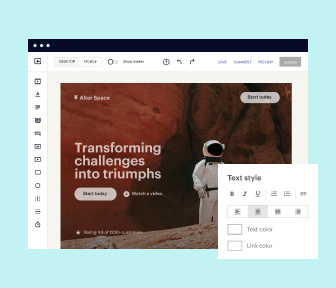
Easy to build without coding
With the intuitive drag-and-drop builder, anyone on your team can create high-converting pages without any knowledge of code or design. Make enhancements to your landing page with custom widgets using Javascript, HTML/CSS, or third-party scripts.
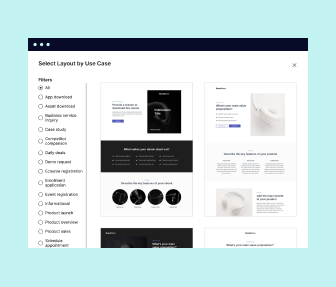
Multiple layouts for any industry and goal
Select from 500+ landing page layouts built to boost conversions across industry-specific scenarios. Customize them by adjusting fonts, adding images, and generating on-brand content with the AI assistant. Quickly scale with Instablocks® and Global Blocks that you can save, reuse, and update globally.
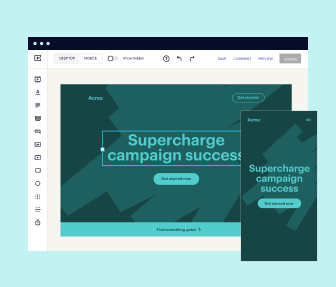
Loads fast and looks polished on any device
Every template is responsive, which means they present professionally on any device and load blazingly fast with our Thor Render Engine. You can also power them up with Google AMP technology to deliver an unparalleled mobile experience and drive higher conversions.
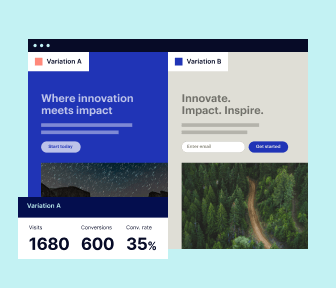
Robust analytics & experimentation
Get real-time updates and reporting across all your devices, showing the number of visitors, conversions, cost-per-visitor, and cost-per-lead. Launch AI-powered experiments, run A/B tests, and use heatmaps to analyze user behavior, then optimize your landing page to maximize conversions.

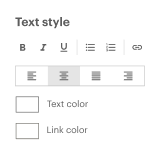
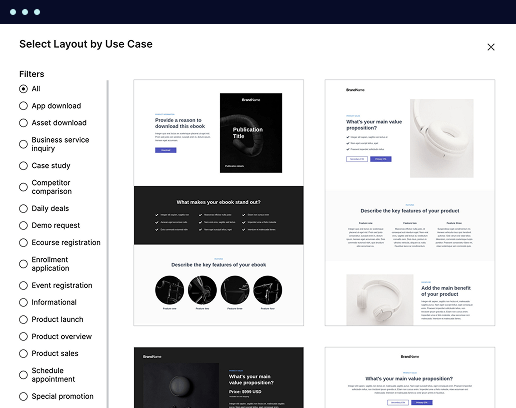
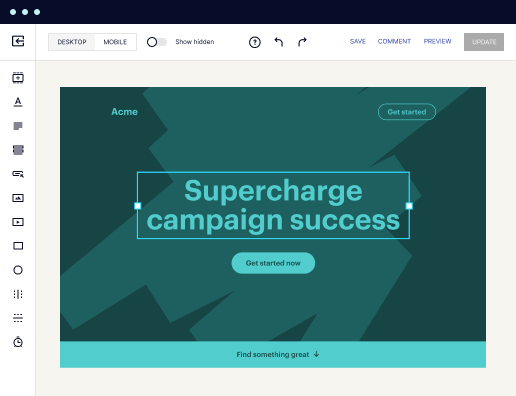
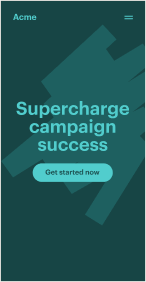
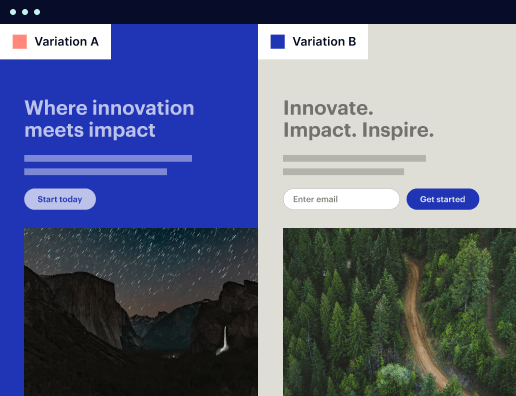

Easy to build without coding
With the intuitive drag-and-drop builder, anyone on your team can create high-converting pages without any knowledge of code or design. Make enhancements to your landing page with custom widgets using Javascript, HTML/CSS, or third-party scripts.
Multiple layouts for any industry and goal
Select from 500+ landing page layouts built to boost conversions across industry-specific scenarios. Customize them by adjusting fonts, adding images, and generating on-brand content with the AI assistant. Quickly scale with Instablocks® and Global Blocks that you can save, reuse, and update globally.
Loads fast and looks polished on any device
Every template is responsive, which means they present professionally on any device and load blazingly fast with our Thor Render Engine.
Robust analytics & experimentation
Get real-time updates and reporting across all your devices, showing the number of visitors, conversions, cost-per-visitor, and cost-per-lead. Launch AI-powered experiments, run A/B tests, and use heatmaps to analyze user behavior, then optimize your landing page to maximize conversions.
All the features you need to build python website templates free download
Explore more featuresLearn how to build python website templates free
Frequently asked questions about python website template free download
Leading the way in building high-performing landing pages





Python html template: Your ultimate how-to guide
Understanding how to effectively leverage Instapage for your landing page and conversion rate optimization (CRO) is pivotal for marketers across various sectors like tech, education, and financial services. This guide provides you with actionable insights that can help transform your campaigns into high-performing assets.
Identifying your campaign goals
Before diving into the features of Instapage, it’s essential to outline your specific objectives. Are you aiming to capture leads, promote a service, or drive sales? Clarity on your goals will guide the design and functionality of your landing pages.
- Define the desired action (e.g., signing up for a newsletter) that reflects your marketing goals.
- Identify key performance indicators (KPIs) to measure success, like conversion rates and customer acquisition costs.
- Assess audience segments to ensure your messaging aligns with their needs and motivations.
Leveraging Instapage templates
With over 100 high-converting templates available, selecting the right one can significantly speed up your workflow.
- Choose templates tailored for your industry, ensuring they reflect best practices for your target audience.
- Utilize Instablocks for repeated elements across pages to maintain consistency and save time.
- Edit templates within the intuitive builder to fit your campaign’s unique branding and objectives.
Optimizing for conversions
Once your landing page is ready, focus on maximizing its performance. Instapage provides numerous tools to refine and test your pages.
- Implement A/B testing to compare different layouts and content approaches to see what resonates best with your audience.
- Use heatmaps to analyze visitor behavior and pinpoint areas for improvement on your landing pages.
- Adjust CTAs and surrounding content dynamically based on audience segments to enhance personalized experiences.
By following these steps, you can effectively utilize Instapage to boost your marketing campaigns.
In conclusion, harnessing the capabilities of Instapage enables you to create landing pages that not only look great but are also designed to convert. Start leveraging these insights today to see tangible improvements in your digital marketing strategy.
Ready to get started? Explore Instapage's robust features and create your high-converting landing page today!
People also ask about python website templates
HTML page template for Python developers
Understanding the importance of HTML in Python development
HTML plays an essential role in web development, acting as the backbone of web applications. For Python developers, understanding HTML is vital since it enables them to combine their backend skills with front-end capabilities. HTML structures the content, making it presentable on the web browser. Whether you're developing a simple static website or a complex dynamic web application, a solid grasp of HTML makes the development process smoother and more efficient.
In the context of Python frameworks, HTML serves as the foundation upon which data is rendered and presented to users. Both Flask and Django utilize HTML extensively; Flask uses Jinja2 for template rendering, while Django has its template system. This integration allows developers to create rich, interactive, and fully-functional web applications that cater to user needs.
HTML is fundamental for structuring web content.
Integrating HTML with Python frameworks enhances functionality.
Understanding HTML aids in better collaboration among developers.
Exploring HTML page templates: Definition and purpose
In the realm of web development, HTML templates are predefined HTML codes that provide a structure for web pages. Within the context of Python, template engines like Jinja2 and Django Templates are widely used. These engines facilitate the dynamic generation of HTML pages by allowing developers to insert variables and expressions directly into HTML files. This practice not only streamlines the development process but also makes it significantly easier to manage large codebases.
The key benefits of using HTML templates are numerous. First, they ensure code reusability, allowing developers to create a template once and use it across multiple pages, reducing redundancy. Second, maintainability improves as developers can update a single template without altering every individual HTML file. Finally, templates can enhance scalability in projects, enabling smooth additions of new features without complicating existing code.
HTML templates promote code reusability.
They enhance maintainability by centralizing changes.
Scalability becomes easier as the project grows.
Guide to creating an HTML page template: Step-by-step
Setting up your development environment is vital for effectively working with HTML templates in Python. Begin by selecting a recommended Integrated Development Environment (IDE). Popular choices for Python developers include PyCharm, Visual Studio Code, and Atom. Once you've chosen an IDE, you'll want to install the necessary libraries and packages. For those working with Flask, installing Flask itself and Jinja2 will be essential. For Django developers, ensure you have Django properly configured along with its built-in templating engine.
Creating a basic HTML template follows a straightforward structure. The template typically includes the and sections, similar to a standard HTML document. However, you'll want to insert placeholders where dynamic content can be injected. For instance, you might use Jinja2 syntax such as {{ variable_name }} to substitute dynamic data passed from your Python backend.
To integrate Python with HTML templates, Flask provides an intuitive way to render templates using the render_template function. This allows you to generate HTML dynamically by passing data from your Python code into your templates. A typical approach is using the format function to format your strings, ultimately feeding them into the HTML structure. Such integration ensures that your web pages are not static but can reflect real-time data based on user interactions or backend processes.
Advanced template features for enhanced functionality
One of the advantages of using HTML templates is the ability to utilize context processors in Django or similar features in Flask to share common variables across multiple templates. This can be particularly useful for setting site-wide configurations or user data that should be accessible throughout your application. For example, in a Django application, you might define a context processor to inject user authentication status into every template, streamlining your development and enhancing user experience.
Moving beyond basic usage, Python developers can combine HTML templates with JavaScript frameworks like React or Vue. This integration adds a layer of interactivity to web applications, enhancing user engagement. When considering this route, it’s crucial to understand best practices for linking front-end interfaces with backend data. Leveraging REST APIs, for instance, can facilitate efficient data transfer between the server and client-side applications, ensuring smooth operation without compromising performance.
Furthermore, ensuring responsive design is paramount in today’s mobile-first world. By incorporating responsive design techniques and CSS frameworks like Bootstrap or Tailwind CSS into your HTML templates, developers can build sites that look appealing across diverse devices. Techniques such as using grid systems or flexbox layouts enhance the visual appeal while guaranteeing usability on mobile, tablets, and desktops.
Navigating the challenges: Debugging and testing templates
For developers new to HTML templates, several common issues may arise, especially in the initial stages. Syntax errors often plague beginner attempts, manifesting through missing closing tags or improper nesting of HTML elements. Additionally, rendering errors can occur if variables are accidentally misspelled or not properly passed to the template. To mitigate these challenges, employing effective strategies such as thorough code review and the use of debugging tools integrated within your IDE can be extremely beneficial.
Testing your HTML templates for reliability is crucial. Unit testing frameworks like unittest or pytest offer robust solutions for validating your templates. You can create test cases that check for expected output or potential errors within template rendering. Moreover, exploring automated testing frameworks can provide an additional layer of verification, allowing you to confirm that templates maintain functionality after code changes, thereby ensuring consistency across your web applications.
Utilizing communities and collectives for enhanced learning
Engaging with online forums and Q&A platforms can significantly boost your learning curve in HTML template usage with Python. Websites like Stack Overflow and dedicated communities on Reddit provide fantastic resources for asking questions and receiving guidance from experienced developers. When posting questions in these forums, ensure that you provide detail and context about the issue you face to attract the most helpful responses.
Joining developer collectives can be invaluable. Participating in communities specializing in Python fosters networking and collaboration opportunities. These groups often hold discussions, webinars, and live coding sessions, providing rich resources to accelerate your learning. By exchanging knowledge and experiences with seasoned developers, you'll build strong connections that can assist you throughout your development journey.
Accessing knowledge and resources on HTML templates
For those keen on deepening their understanding of HTML templates, several curated educational resources are available. Websites like W3Schools, freeCodeCamp, and Mozilla Developer Network offer extensive tutorials and guides on HTML and Python integration. Additionally, consider exploring online courses from platforms like Udemy or Coursera, which cover everything from basic HTML to advanced front-end frameworks and their integration with back-end technologies.
Furthermore, it's essential to stay informed about innovative template frameworks. A comparison of popular options such as Flask's Jinja2, Django's templating engine, and others can provide insights into which best suits your project needs. Watching for future trends in template technologies will equip you with knowledge that can streamline your web development workflow and improve project efficiency.
Conclusion: Transforming development processes with HTML templates
HTML templates play a vital role in enhancing the workflow and productivity of Python projects. By offering structured approaches to dynamic content generation and promoting code reusability, they transform how developers construct web applications. As the landscape of web development continues to evolve, embracing HTML templates becomes increasingly essential for ensuring team efficiency and project scalability.
Looking ahead, the future of HTML and Python development seems promising. With the ongoing advancements in template technologies and frameworks, developers can expect enhanced features and capabilities that will further facilitate smooth integration of HTML with Python. Adapting to these changes and continually honing your skills will position you as a proficient developer in the ever-evolving digital landscape.
Ready to skyrocket conversions?
Supercharge your ad campaigns with high-performing landing pages
Get started